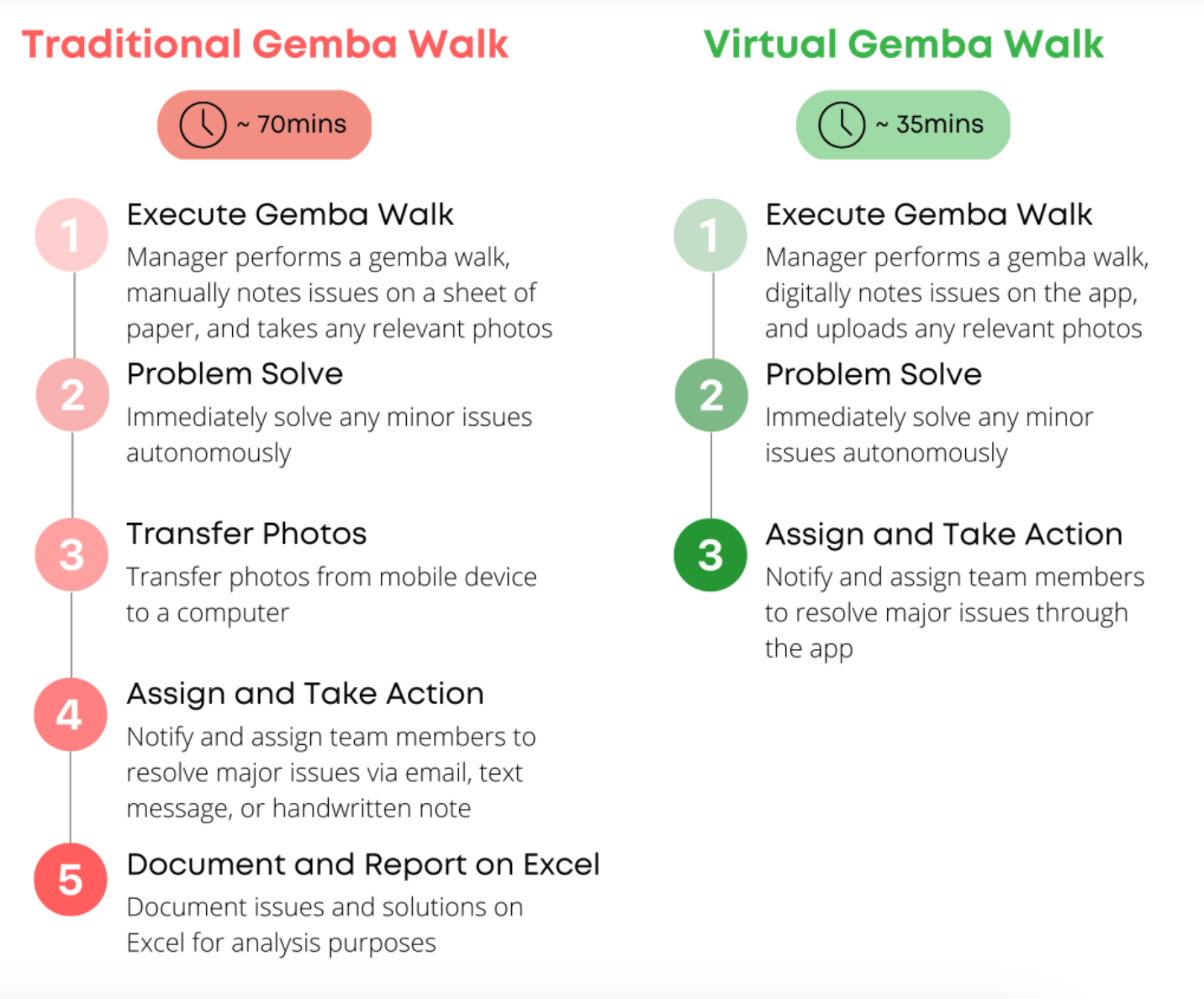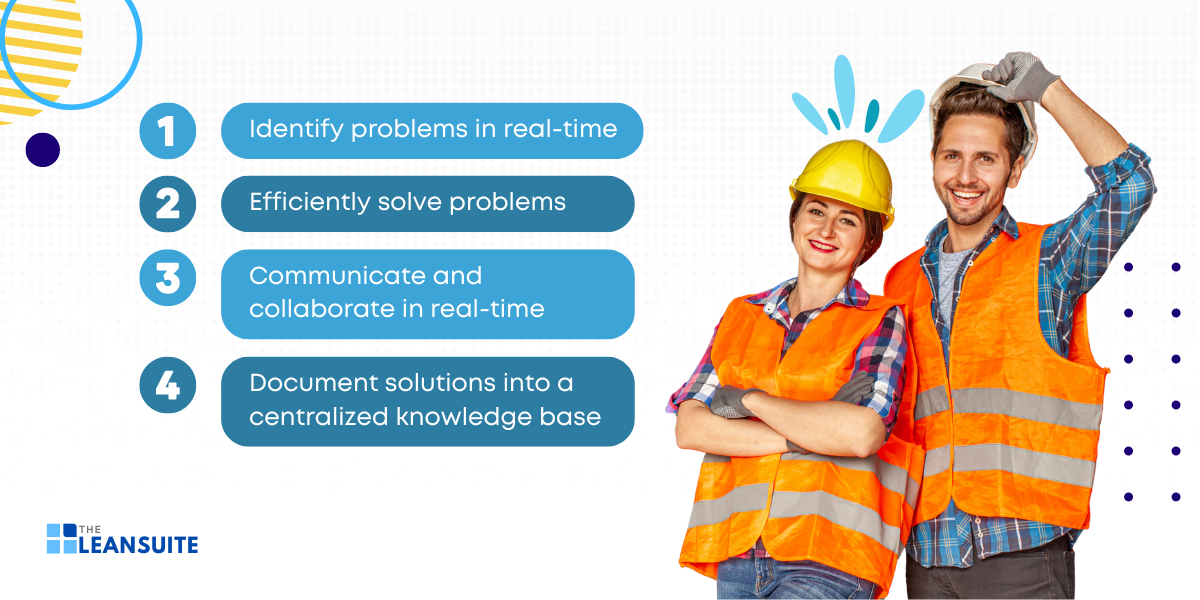Imagine transforming the traditional, time-consuming process of a Gemba walk into a streamlined, efficient, and data-rich experience right at your fingertips. By digitizing your Gemba walks and leveraging a virtual Gemba walk app, you can unlock numerous benefits that go beyond just convenience. This innovative approach not only saves you time and resources, but also provides you with actionable insights through real-time data collection and analysis, fostering a culture of continuous improvement. Continue reading to explore why using a virtual Gemba walk app is a game-changer for modern manufacturers.
What is a Gemba walk?
A Gemba walk is a management practice originating from the manufacturing industry, specifically within the Lean manufacturing philosophy.
It involves managers and leaders going to the “Gemba,” a Japanese term meaning “the actual place” where work is done, to observe business processes as they happen, engage with employees, and identify opportunities for improvement. In manufacturing, the Gemba is the shop floor — the “real place where manufacturing is completed”. So, a Gemba walk is a tour of the shop floor.
This practice is deeply rooted in the 5G Methodology, which includes Gemba (the actual place), Gembutsu (the actual things or equipment), Genjitsu (the actual facts or data), Genri (the underlying principles), and Gensoku (the standard procedures). By following these principles, managers can gain a comprehensive understanding of the real-world conditions and challenges faced on the production floor.
Essentially, a Gemba walk promotes direct observation, fosters open communication, and supports a culture of continuous improvement by addressing issues at their source and making informed decisions based on firsthand insights.
The purpose of a Gemba walk
A Gemba walk serves various purposes depending on the specific goals and needs of your organization.
While traditionally associated with Lean manufacturing and process improvement, the scope of a Gemba walk can extend to numerous facets of operational excellence. For instance, a safety Gemba walk is designed to identify and mitigate potential hazards in the workplace, ensuring that safety protocols are not only in place, but are also being effectively followed.
During a Gemba safety walk, leaders and team members observe the work environment, engage with employees to understand their safety concerns, and examine equipment and procedures to spot any risks. This proactive approach not only helps in preventing accidents, but also fosters a culture of continuous safety improvement, emphasizing the organization’s commitment to the well-being of its workforce. Thus, the versatility of a Gemba walk makes it a valuable tool for addressing a wide range of operational objectives.
Traditional Gemba walk vs virtual Gemba walk: What’s the difference?

Traditional Gemba walk
Traditionally, Gemba walks are performed by managers, leaders, and other team members using pen and paper. In essence, a checklist of essential Gemba walk questions is created on paper, then a pen is used to track the progress as they tour the shop floor. But, occasionally, they will use an Excel spreadsheet to gather statistics and analyze data from identified issues and their resolutions.
In short, traditional Gemba walks are a wasteful activity. This is because once an issue has been identified during a Gemba walk, a manager or leader needs to take quick action. But, they’ll need to figure out:
- How to efficiently transfer an issue and its relevant information to the correct person
- How they can log it as an opportunity for improvement
- How they can effectively share relevant information in a meeting, and
- How they can follow-up with the issue that has been assigned to someone
Virtual Gemba walk
When it comes to the governing principles, performing a virtual Gemba walk is no different than performing a traditional Gemba walk. Essentially, all a virtual Gemba walk does is digitizes the traditional Gemba walk process. In other words, virtual Gemba walks enable you to efficiently document issues with a cloud-based application.
What are the benefits of using a virtual Gemba walk app?

1. Identify problems in real-time
Manufacturing plants and factories that don’t leverage innovative softwares and applications often have a lot of problems that go unreported. Consequently, frontline workers just learn to live with them. This results in bottlenecks, affects costs, and creates quality issues.
By performing your Gemba walks virtually, managers, leaders, and team members can address both big and small issues. This is done by using their mobile devices to tag equipment and attach images and videos to further highlight, and clearly show what the problem is and where it is located.
What’s more, because a virtual Gemba walk app makes it easy for workers to capture problems, they are more likely to be proactive and share their observations before a small issue becomes a big problem.
2. Efficiently solve problems
Traditionally, solving shop floor problems has been a time-consuming and labor-intensive process that often required considerable administrative effort.
Once a problem was identified, managers or engineers had to personally visit the site to inspect the issue firsthand, which could lead to delays and inefficiencies. With the introduction of a virtual Gemba walk app, this process has been completely transformed. This app allows users to capture detailed photos and videos of the problem directly within the app. Thus, enabling a comprehensive visualization of the issue and its surrounding area. This means that stakeholders can assess and address the problem from any location, at any time, significantly reducing the time and effort required for problem-solving.
By leveraging the capabilities of a virtual Gemba walk app, you gain valuable insights that can enhance your operational efficiency and responsiveness. Ultimately, leading to more effective and timely resolutions.
3. Communicate and collaborate in real-time
Utilizing a virtual Gemba walk app is highly advantageous as it facilitates real-time communication and collaboration among team members, whenever and wherever they are.
This digital tool empowers workers to interact and collaborate seamlessly, enhancing their ability to share insights and updates instantly. In essence, this instant communication helps create a more connected and engaged workforce by eliminating the need for employees to wait for scheduled meetings to share crucial information. Moreover, it enables instant feedback to ensure that any and all issues or ideas are addressed promptly.
By integrating a virtual Gemba walk app, you create a dynamic and efficient work environment where collaboration thrives and continuous improvement efforts are sustained.
4. Document solutions into a centralized knowledge base
One notable benefit of using a virtual Gemba walk app is the ability for teams to document solutions into a centralized knowledge base.
By capturing and recording the details of solved problems, especially those that are recurring, you can convert these solutions into standardized troubleshooting guides, pending approval. This ensures that all relevant information and solutions are stored in a single, easily accessible hub. Consequently, employees can quickly retrieve these documents on any device, enhancing efficiency and reducing downtime by providing immediate access to proven solutions.
This centralized approach not only streamlines problem-solving but also fosters a culture of continuous improvement and knowledge sharing across the organization.
Virtually tour your shop floor with LeanSuite
LeanSuite is an all-in-one, cloud-based Lean Enablement Software that offers solutions designed to support and enhance your daily manufacturing operational activities. One of them being the Gemba Walker, a virtual Gemba walk app that facilitates remote Gemba walks.
With LeanSuite’s Gemba Walker, instead of coordinating schedules and assigning a period of time dedicated to performing an actual Gemba walk, you can digitally integrate your Gemba activities into your everyday operations.





